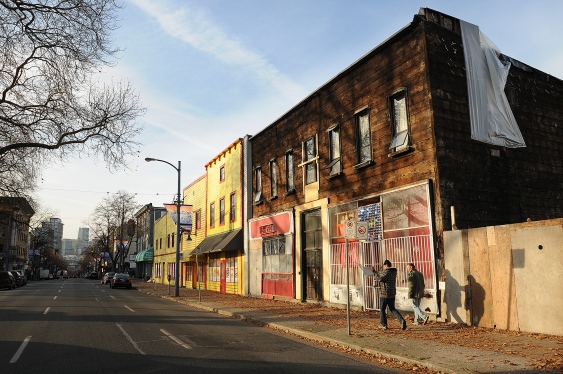Plans for new Downtown Eastside housing debated
City prepares to release new community plan
Mike Howell
Van. Courier

The City of Vancouver is expected to release its report on a new community plan for the Downtown Eastside before the end of the year. photo Dan Toulgoe.
The type of new housing that should be built in the heart of the Downtown Eastside continues to generate debate as the City of Vancouver prepares to release its new community plan for the neighbourhood.
The debate has centred on the city’s pre-planning documents that call for a mix of 60 per cent social housing and 40 per cent rental housing in a large area known as the Downtown Eastside Oppenheimer District.
The documents do not indicate any potential for developers to build stand-alone market housing in the district, although the 60/40 social-rental mix does allow for some private homes within a complex.
The district in question covers 16 full blocks and five partial blocks, which include streets around Oppenheimer Park and a strip that runs west along the East Hastings corridor.
The area has the majority of the Downtown Eastside’s assets, including social housing, affordable food stores, social services and gathering places.
Vision Vancouver Coun. Andrea Reimer pointed out the district is one of eight planning areas in the Downtown Eastside. In addition, she said, the majority of new housing being built in Chinatown, Gastown and Victory Square is condominiums.
“So if you’re looking at the whole neighbourhood, there’s nothing radical being proposed here,” Reimer told the Courier after a forum on the future of the Downtown Eastside Nov. 21 at Simon Fraser University’s downtown campus.
“There’s a concept to secure the low-income tenure in the area, which seems like a very reasonable one to me.”
That concept is one Michael Geller, an architect-developer and former NPA council candidate, argued against in last week’s forum, which attracted about 50 people including Ray Spaxman, the city’s former planning director.
Though Geller recognizes that some market housing could be allowed under the plan, he questioned whether a person would want to buy a condominium in a building where the majority of units are social and rental housing.
Geller said he supports replacing “decrepit” single-room-occupancy hotels with new social housing. But, he added, it is important to incorporate stand-alone market housing in a community plan that wouldn’t force low-income people from the neighbourhood.
“It’s that sharing of the area that I think, over time, will result in a healthier neighbourhood,” he said.
Spaxman said his reading of the documents would allow, for example, 12 units of market housing, seven units of rental housing and 11 units of social housing in a new 30-unit complex.
But Spaxman pointed out the difficulty in advancing the discussion on the Downtown Eastside without the full plan in people’s hands. He is wary of statistics being promoted by activists and claims made by people close to the discussion.
“We must not go forward with some ideological position,” he said.
“We have to get the facts together, we have to look at what ramifications of all these policies are. We need to do it and take the time to do it properly, otherwise we shall rush into getting a plan done because it’s an election year and we want to get it out of the way.”
Pete Fry, the chairperson of the Strathcona Residents’ Association, said home ownership doesn’t dictate whether a person stays in the neighbourhood and participates in the community.
“I think tenure is dictated by safe, secure, affordable housing where you’re not going to fear renoviction,” said Fry, who is more concerned that proposed increases in building heights could turn the Downtown Eastside into a real estate speculator’s market.
Brian Jackson, the city’s director of planning, responded to Geller’s concerns about the lack of stand-alone market housing in a letter, which he allowed to be shared with the public.
Jackson noted the Oppenheimer District comprises about 15 per cent of the geographic area of the Downtown Eastside, where many residents are facing “significant health and affordability challenges.”
“It is a sensitive part of the community that is facing significant development pressure and it has the potential to change very quickly, which may negatively impact the most vulnerable residents,” Jackson wrote.
“The City wants the neighbourhood to change for the better without creating more homelessness and where the changes result in improved housing options for many of the existing residents.”
The Downtown Eastside plan is expected to be released before the end of the year.
© Copyright 2013